Art & Exhibitions
Liza Lou’s Iconic ‘Trailer’ Reemerges for the First Time in a Decade, Its Critique Still Pointed
Taking the form of a 1949 mobile trailer, the work unpacks America's dark obsessions.

Taking the form of a 1949 mobile trailer, the work unpacks America's dark obsessions.

Brian Boucher

Halloween at the Brooklyn Museum, dear reader, is a riot. The museum is a polling place, and when I visited, early voters streamed through, poll workers letting out a round of applause every time a first-time voter cast their ballot. School groups abounded, and education department staffers were reportedly giving school tours upstairs in costumes based on works in the institution’s collection.
Also in the mix, just a few feet from where the voters stood on line in the lobby, is Trailer (1998–2000), a resonant artwork by American artist Liza Lou that plumbs Hollywood images of crime and violence, toxic masculinity and communal femininity, fine and decorative art, and the American obsession with guns and hunting—all packed into one 35-foot-long 1949 Spartan Royal Mansion mobile trailer. It’s on public view for the first time in a decade.
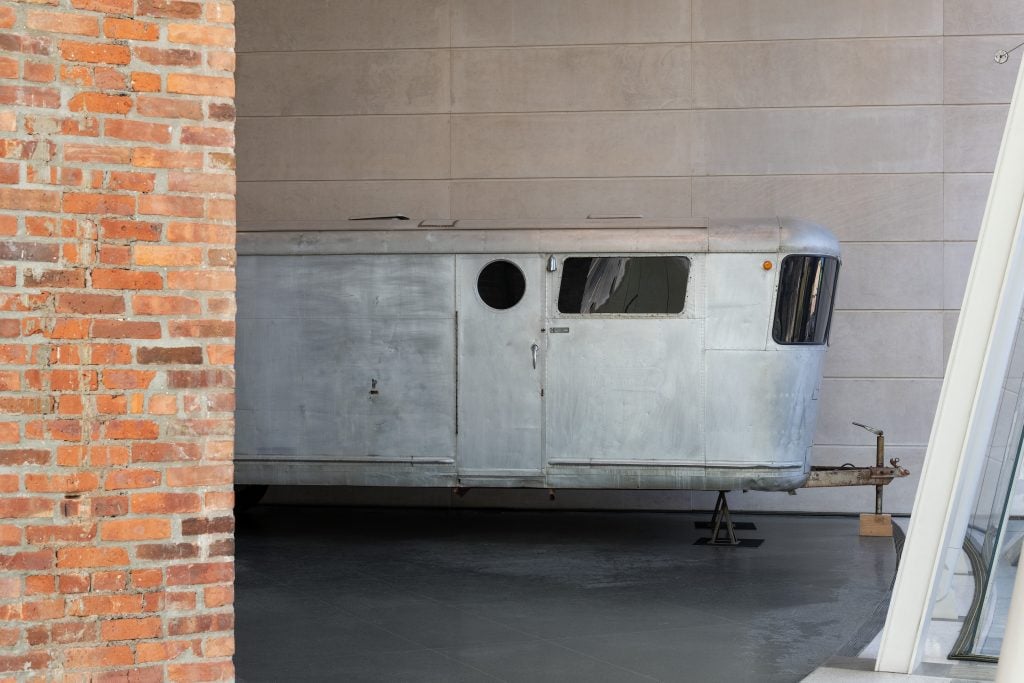
Liza Lou, Trailer (1998-2000). Courtesy Brooklyn Museum. © Liza Lou. Photo: Danny Perez.
Step up into a little space for one person at a time to survey the interior, and you’re transported in the dimly lit black-and-white world, whose interior, save for the quilted fabric black ceiling, is covered with millions of black and white beads, from the linoleum-tiled floor to the top of the (faux?) wood-paneled walls. The compact space is packed with the owner’s possessions. The curtains are all drawn, lending an air of secrecy or even malice.
Whoever it was loved their guns; a shotgun is propped against the wall by the door, while another hangs above the couch. A lamp is propped on a pile of three books: Proud Guns, Shooter’s Bible, and How to Hunt Deer. (The latter two, at least, show up online as real books.) A copy of Guns magazine (“Be a pistol champ”) sits on a coffee table along with a hunting knife, a pack of Marlboros, and a whisky bottle. A pornographic magazine resting on the floor nearby points to much darker territory.

Liza Lou, Trailer (1998-2000). Courtesy Brooklyn Museum. © Liza Lou. Photo: Danny Perez.
The piece prompted me to think Lou was ahead of the game in thinking about so-called toxic masculinity, but a quick Google revealed that the term was coined during the men’s movement of the 1980s, and thus likely on the artist’s mind as she conceived the piece.
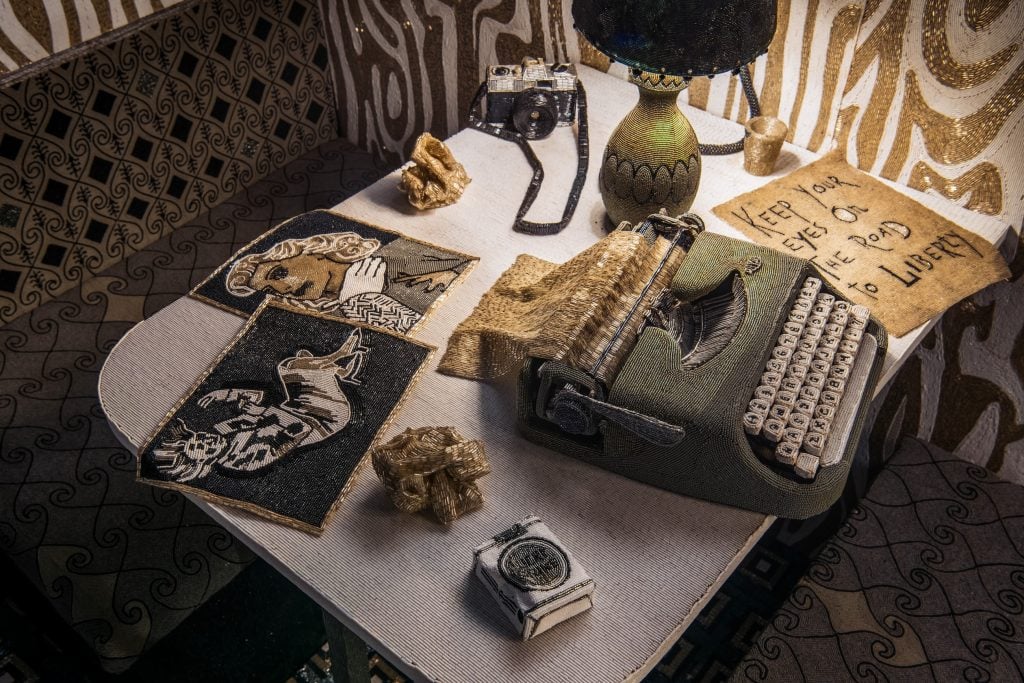
Liza Lou, Trailer (1998-2000). Courtesy Brooklyn Museum. © Liza Lou. Photo: Danny Perez.
Keep looking around, and you see a typewriter perched on the table in the kitchenette. Next to it is a sheet of paper with the words “Keep your eyes on the road to liberty,” a reference to an unsolved 1937 attempt on the life of Los Angeles District Attorney Buron Fitts. Those words were mailed to Fitts just hours before he was shot at and slightly wounded, possibly connected to a strike at a Douglas Aircraft Factory, according to a March 8 New York Times item. Are we in the home of a would-be assassin?
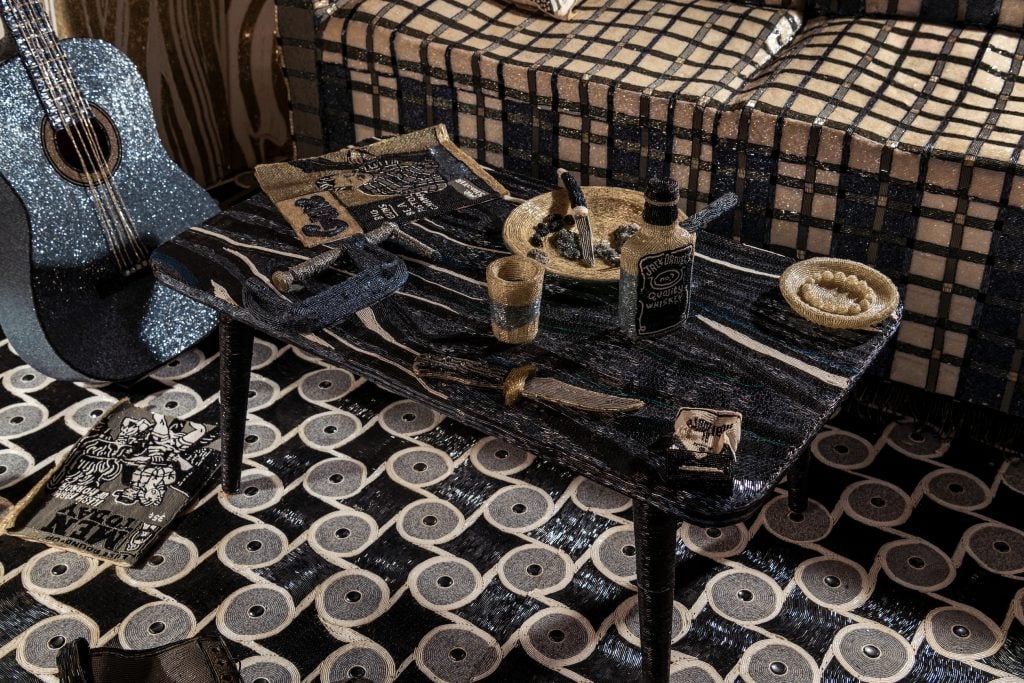
Liza Lou, Trailer (1998-2000). Courtesy Brooklyn Museum. © Liza Lou. Photo: Danny Perez.
A television appears to play just out of sight in the bedroom; we see flashing lights and hear dialogue from what sounds like a classic film noir, where hardened gangsters discuss a numbers-running operation. What’s more, a leg is stretched out on the floor, visible only up to the ankle. A dead body? A woman’s? It inevitably recalls the feet of the Wicked Witch of the East poking out from under Dorothy’s house in The Wizard of Oz. (Perhaps incidentally, the film dates from 1939, just two years after the attempt on Fitts’s life.)
“The work is labor-intensive but also meditative,” said Catherine Futter, the museum’s senior curator of decorative arts, who joined me for a while. “She’s looking at the big issues of life but it’s also internal.” Part of Trailer’s inspiration, she revealed, was not just Hollywood film noir in general but in particular Orson Welles’s Touch of Evil (1958), one of the greats of the genre, in which the darkness is leavened by a liberal sprinkling of irony and black humor, which Futter sees in Lou’s piece as well.
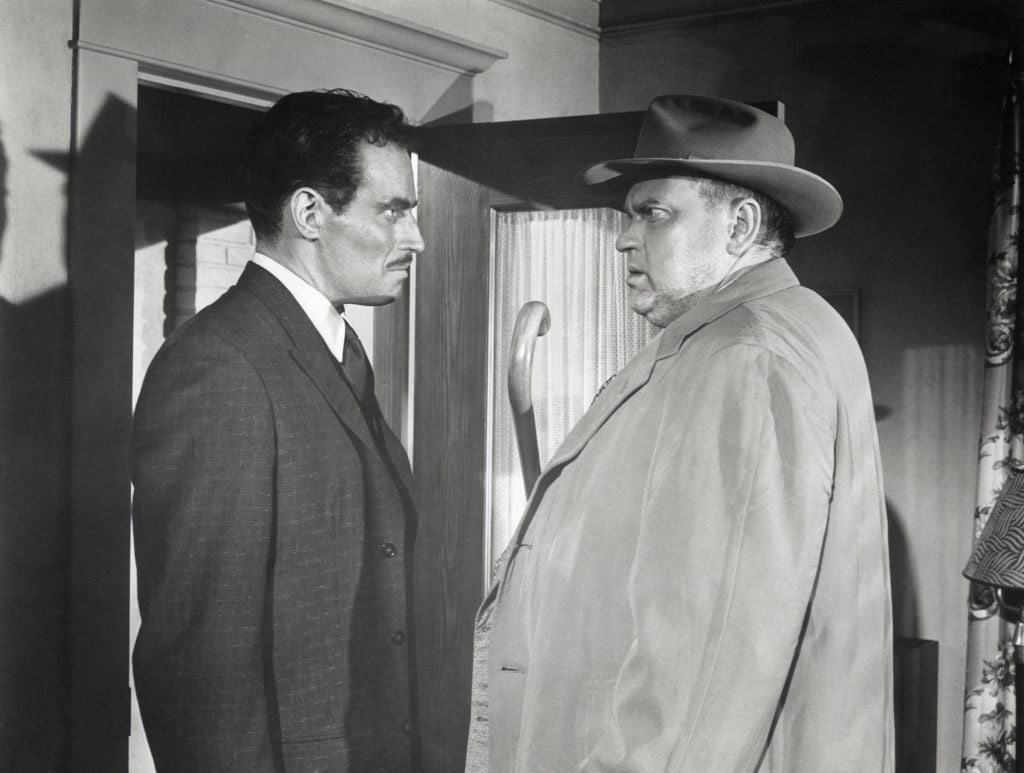
Actor Charlton Heston with director and screenwriter Orson Welles on the set of his movie Touch of Evil (1958). Photo: Sunset Boulevard/Corbis via Getty Images.
The obsession with firearms in the piece comes across, Futter pointed out, a bit more nostalgically now than it might have a quarter-century ago. Indeed, the revolvers and shotguns in Trailer, if the piece were done today, might be more likely to be assault-style rifles and automatic weapons. Guns tragically remain the leading cause of death for children and teens, and disproportionately affect people of color, according to a recent report from the Johns Hopkins Center for Gun Violence Solutions.
A group of seventh-graders, polled by this reporter, eagerly posed questions—why did he have so many guns? Is that a dead body?—before sharing their TikTok handles, presumably in hopes of boosting their follower counts. (Can’t knock the hustle!)
An educational video playing nearby sates visitors’ curiosity with interviews with the artist and conservators who worked on the piece. “What would sexy maleness be?” asks Lou, recounting one of the subjects she felt compelled to address.
Conservators discuss some of the challenges of putting a work on show that had long sat outdoors at the sculpture park created by collectors Sherry and Joel Mallin, who recently donated the piece. Some 10 conservators worked on it for six weeks, cleaning it and removing individual beads that had fallen off in transit or during handling, and clearing up evidence of incursions by mice and squirrels. You’d never guess—inside, the trailer smells fresh and clean. Such a large piece also presented installation challenges; the museum had to remove three of the glass doors on its facade to be able—barely—to fit it inside.
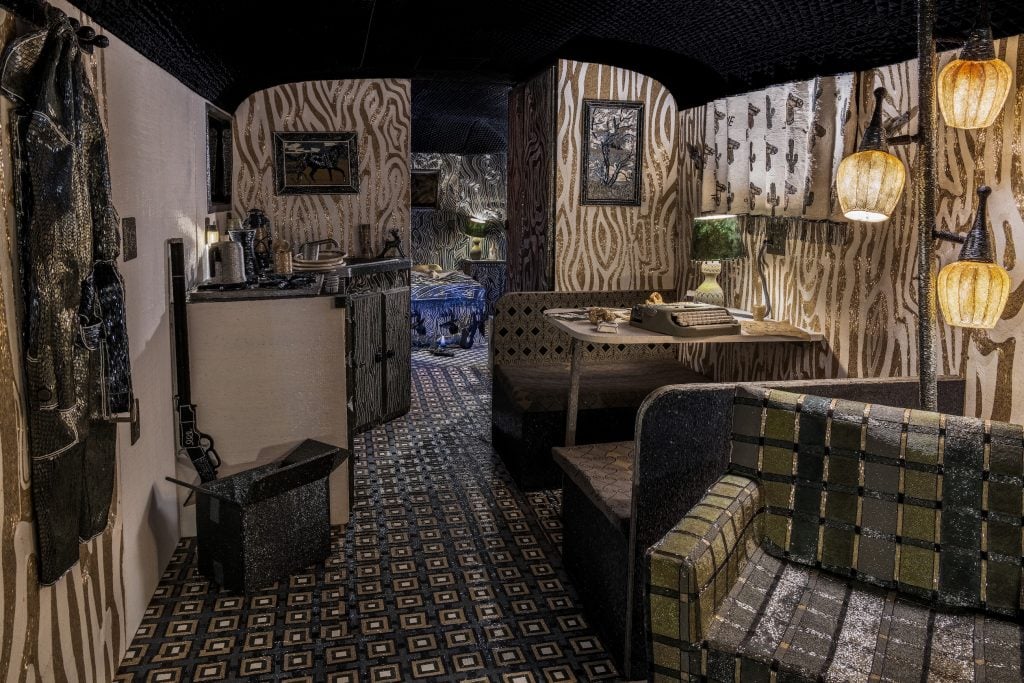
Liza Lou, Trailer (1998–2000). Courtesy Brooklyn Museum. © Liza Lou. Photo: Danny Perez.
Just about a half-hour away via the 2 or 3 subway train is the Whitney Museum of American Art, which owns Lou’s installation Kitchen (1991–96), finished two years before she began work on Trailer. That piece (not on view, alas) could serve as a pendant to this one, depicting a feminine-coded locale, and created not in black and white but in a veritable party of colored beads.
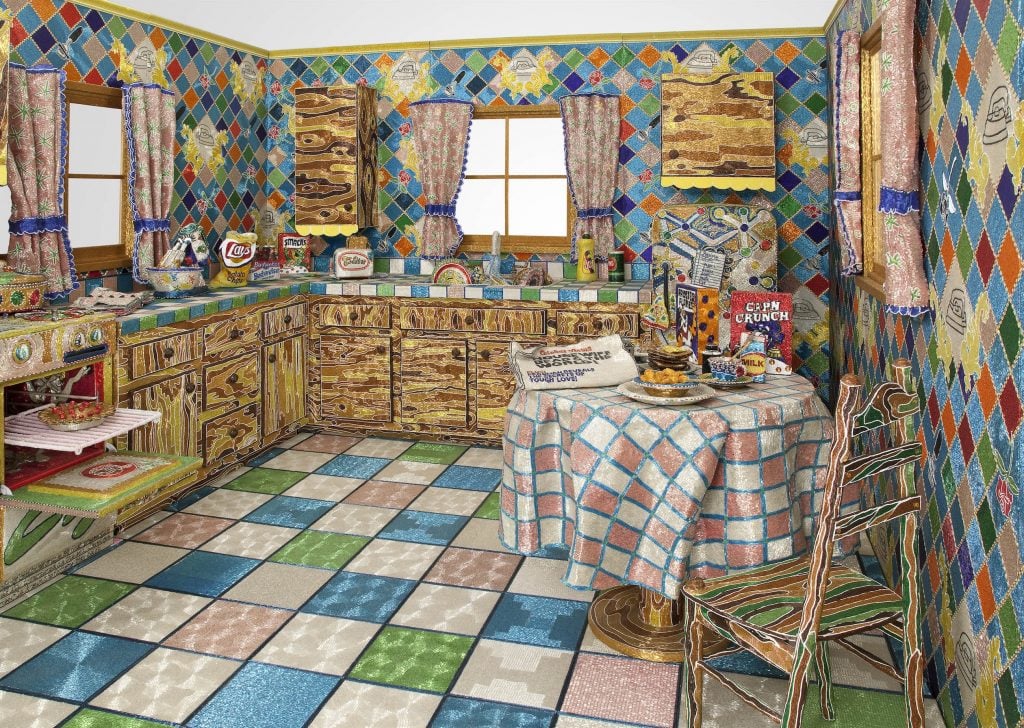
Liza Lou, Kitchen (1991-96). Photo: Tom Powel Imaging. Courtesy the artist and Lehmann Maupin, New York, Seoul, and London.
Where Trailer has revolvers, whisky bottles, and Marlboros, Kitchen has Lay’s potato chips and a six-pack of Budweiser, a box of Tide laundry detergent (“the washing miracle”), Cap’n Crunch, and Frosted Flakes. The wallpaper carries messages of domestic labor like an iron, and a passage from an Emily Dickinson poem that runs “She rose to His Requirement, dropped the playthings of her life to take the honorable work of woman and of wife.” The work, Lou has said, “argues for the dignity of labor,” presumably both of the fictitious woman occupying the beaded kitchen as well as of the artist.
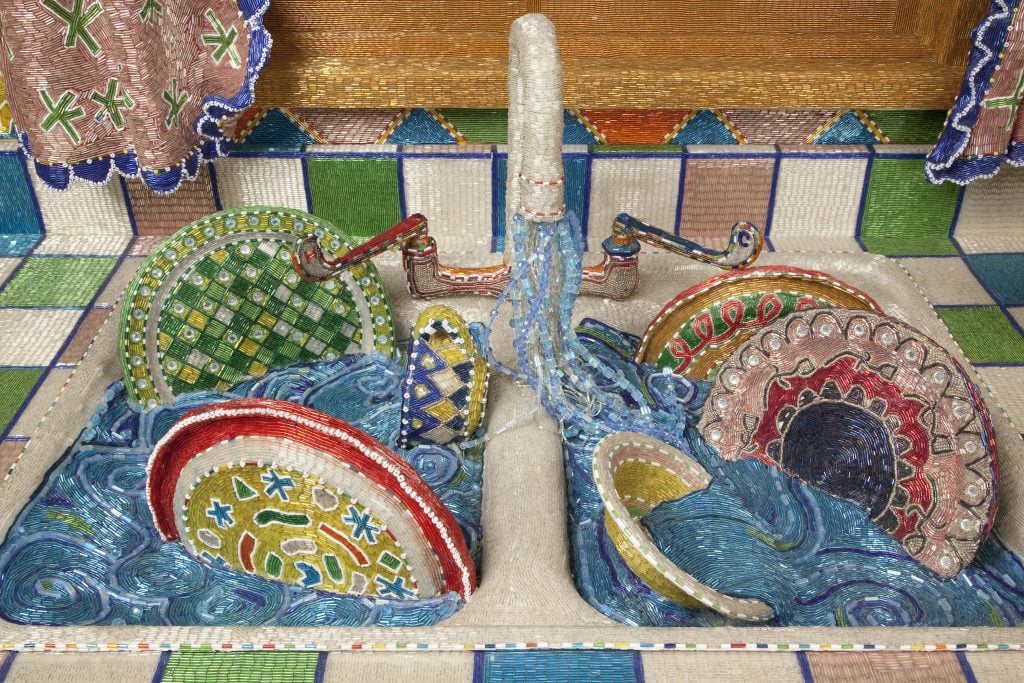
Liza Lou, Kitchen (1991-96), detail. Courtesy the artist. Photo: Tom Powel Imaging.
So if you’re in the city, head to the Brooklyn Museum and spend some time contemplating America, gender, firearms, and all the other dimensions of this rich piece. Or, if you’re anxious because of the heightened drama of our current moment as the voters stream in and out, and you need a more meditative experience, maybe just count the beads, one by one.
“Liza Lou: Trailer” is on view at the Brooklyn Museum, 200 Eastern Parkway, Brooklyn, New York.